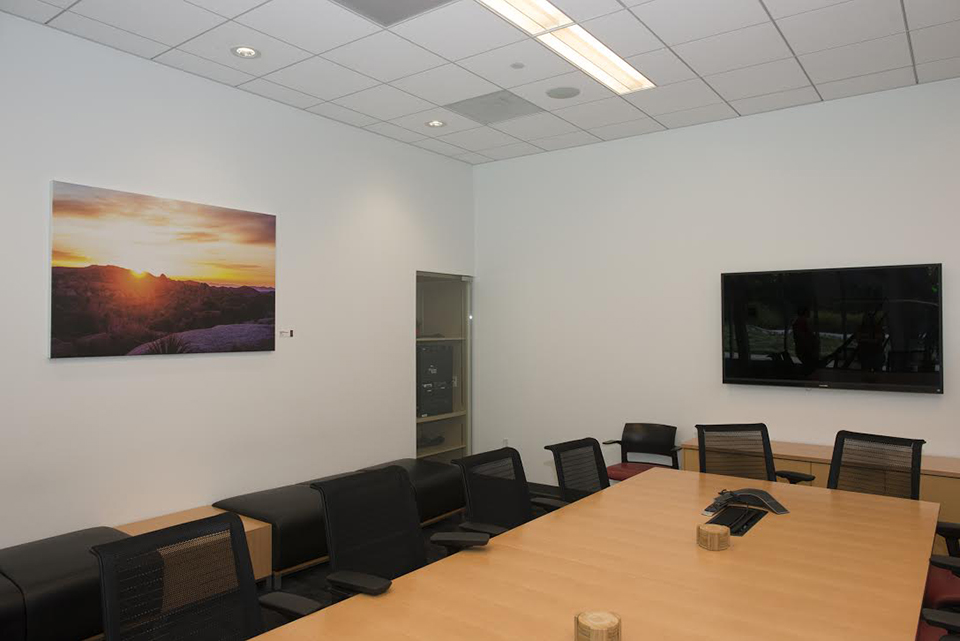USU Hires New Curator for Student Art Collection, Expands Arts Commitment
The staff and student workers of the University Student Union (USU) at California State University, Northridge have long shown a passion for displaying students’ artwork, but in 2017, they have turned that passion into a pièce de résistance.
This spring, the USU hired alumna Ariel Mazariegos ’17 (M.F.A., Art) as the new art curator in charge of the USU Student Art Collection. Mazariegos oversees where the students’ art will be displayed and acts as the mediator between the student artists and the USU. Her newest project is a website where people can see a map of all art displayed at the USU — the website is expected to go live by the end of the 2017-18 academic year.
“I’m curating the space and starting to ask questions [such as], ‘How does a student navigate the space?’ and ‘How does a viewer see this?'” Mazariegos said. “I’m interacting with the spaces, and all sorts of things come into play, like the colors of the wall [and] lighting.”
The expansion of the USU Student Art Collection is an important goal, said James Matzen, USU graphic designer, and Michael Niles, USU marketing manager. Both hope the art will inspire CSUN students and expose them to a new range of art that they would not normally see in exhibits.
“Students really want to see other students’ stories,” Matzen said. “It helps connect them with their fellow students around campus. A lot of the narratives and stories we may see through the art are universal, and students can connect to it.”
The USU officially launched its Student Art Collection in 2006, which was created by USU Executive Director Debra Hammond and Department of Art chair Edward Alfano in the mid-1990s.
Alfano had seen empty display cases during a stroll around the USU, and he suggested to Hammond the idea of placing student art from the department in the cases. Hammond agreed, and their partnership began.
“For years, I was putting up projects from my students [in the display cases], and I would change them monthly, ” Alfano said. “That was my first interaction with Debra, and [I saw] her interest in showing students’ art for the benefit of all.
“The USU is one of the few organizations on campus actively pursuing the mission to showcase student art,” Alfano said. He said he believes an organization like the USU supporting student art expresses that the university cares about the fine arts and wants to integrate it as much as possible.
Every year, the USU staff buy pieces from CSUN art exhibitions that showcase the work of undergraduate and graduate art students, to expand and diversify the Student Art Collection.
In 2016, USU staff partnered with students in CSUN’s Public Art class to create artworks for the Oasis Wellness Center, a facility on campus where students, faculty and staff can go to relax, revive and decompress. Hammond and Jimmy Francis, director of the Student Recreation Center (SRC), led the collaboration between the Public Art classes and the Oasis Wellness Center.
“It goes back to the Student Union’s commitment to student art,” said Francis. “If we’re going to build a building, we are going to put student art in it. There’s art in the conference room here [at the SRC], a sculpture at the end of the rec center [and] we’d like to get more art in the Oasis conference room as well.”
Unwind, one of the works created by Victor Castaneda, Naomi Nadreau, Garen Novruzyan and Emi K. Williams, hangs above the fireplace in the Oasis. Another work, Wonderwall, created by Victor Campos, Michelle Jacobson, Trevor Curran, Jae Kitinoja and Jordyn Kieffer, is mounted on the front wall of the entrance on either side of the door.
The final piece, Pillars of Life, by Joyanna Cazares, Tanner Gilliland-Swetland, Gabriela Herrera, Tanya Nolan and Mei Zhao, is an interactive artwork that stands in two locations — in the Contemplation Garden and facing the outdoor lounge. The sculpture consists of resin seeped into the cracks of two large wooden pillars, reminiscent of telephone polls. Hollowed out, at arm’s length, is a space with a tin canister. Inside, students can find notebooks with journaling prompts such as, “What advice would you give CSUN students?” or “Draw something that represents your time at CSUN.” Students can fill out pages of the notebooks and return them to the space. Oasis visitors also can choose to read the advice and thoughts, or make additional comments of their own.








 experience
experience